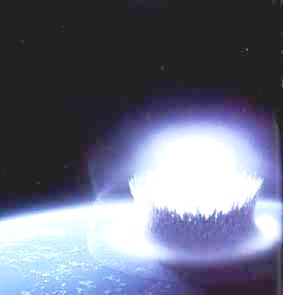Hiroshima is the largest city in the Chūgoku region of western Honshū, the largest island of Japan. Hiroshima was founded on the river delta coastline of the Seto Inland Sea in 1589 by Mōri Terumoto.
A city destroyed by an Atom Bomb ( at 8:15 -Hiroshima Time) known as “Little Boy”, a gun type fission weapon with 60 Kilograms (130 lb) of Uranium-235, took 57 seconds to fall from the aircraft to the predetermined detonation height of about 600 meters (2000 ft) above the city.
An estimate suggested that 69% of Hiroshima’s buildings were destroyed and 70,000–80,000 people or some 30% of the population of Hiroshima were killed immediately, and another 70,000 injured. Over 90% of the doctors and 93% of the nurses in Hiroshima were killed or injured—most had been in the downtown area which received the greatest damage. So, how many people was a sacrifice to this bomb? Those who had lived through the catastrophe placed the number of the deaths at least 100,000.
In the Milky Way Galaxy, there lies another destination for people to stay, its called ‘Earth’. Here is a description of what Earth is like: It’s the third planet from the Sun, and the fifth-largest of the eight planets in the Solar System. It is also the largest, most massive, and densest of the Solar System’s four terrestrial (or rocky) planets. It is sometimes referred to as the World or the Blue Planet.
It’s the Home to millions of species including humans.
Imagine this Earth being destroyed by a thousand times strong force of Mother Nature engulfing from all sides. Tropical cyclones out at sea causing huge waves, torrential rains, high winds disrupting and destructing everything on the way causing wide spread demolition. Very strong winds stirring up water and destroy buildings, bridges, outside objects, turning loose debris into deadly flying projectiles. Sea level rising and you have no place to go. You see the end of your only living city in the Milky Way; ‘THE EARTH’. Imagine solar storms bombarding this ‘Earth’ with lots of radiation energy, knocking out power grids and destroying satellites and you go back to the Dark Age suddenly without any warning. Is it just our fantasy or it may happen some day? Only time can answer to these questions.
It was during the 1980s that the possibility of rapid climatic change occurring at the time-scale of human life more or less fully recognized, largely due to the Greenland ice core drilled at Dye 3 in Southern Greenland (Dansgaard et al., 1982, 1989). A possible link between such events and the mode of operation of the ocean was then subsequently suggested (Oeschger et al., 1984; Broecker et al., 1985; see Broecker, 1997, for a recent review).
The Second Assessment Report, IPCC reviewed the evidence of such changes since the peak of the last inter-glacial period about 120 thousands of years before present (BP). It concluded that:
(1) Large and rapid climatic changes occurred during the last Ice Age and during the transition towards the present Holocene;
(2) Temperatures were far less variable during this latter period
(3) Suggestions those rapid changes may have also occurred during the last inter-glacial period, which requires confirmation.
Calculations are not so easy. Researchers need to understand the behavior of the major ice sheets that cover Greenland, Antarctic and Arctic. Any of these collapses and we are in danger. While computer models now yield an increasingly sophisticated understanding of how a warning atmosphere would behave, such models have yet to fully encapsulate the complex processes that regulate ice sheet behavior.
“The question is: Can we predict sea level? We have to watch the oceans to see what happens and we may observe the change much more than we ever predict it.
There’s a continent of topography sitting under Antarctica. Everything there has an impact on how the ice sheet flows, and very little of that has been mapped.
Whatever it is, the world has been getting warmer by 0.2 degrees Fahrenheit every decade, a U.N. panel found this year, in part because of carbon dioxide and other human-generated gases that trap heat in Earth’s atmosphere. By nature’s clock, the warming has come in an instant. The mechanisms that helped animals adapt during previous warming spells — evolution or long-range migration — often aren’t able to keep up. Scientists say that effects are beginning to show from the Arctic to the Appalachian Mountains. One study, which examined 1,598 plant and animal species, found that nearly 60 percent appeared to have changed in some way.
Some of the best-known changes are happening near the poles, where the air and the water are warming especially quickly. As they do, sea ice is receding. For some animals, this has meant literally the loss of the ground beneath their feet.
So, who knows when we lose the ground below our feet? This could be the annihilation story of a city ‘Earth’ in Milky Way, where humans lived.
Disaster Management specialists are always on the move. Making plans and policies far in advance to meet the challenge of climate change. So, no matter if Copenhagen could show us the way or not, we need to be ready personally. We need to act fast and make a move to know the details of climate change and its solutions.
Any wrong move by the Nations could leave the Aliens (if ever they exist) celebrate ‘Earth Day’ in a far away planet only to tell a tale of another annihilation story.
===
Kindly give your feedback.
Please feel free to contact the disaster management consultant, in case your Organization needs any consultancy on Disaster Management.
Thanks and Regards,
Mr. Mainak Majumdar
Disaster Management Specialist and Consultant



You must be logged in to post a comment.